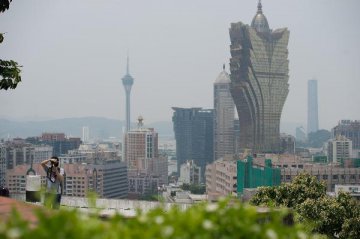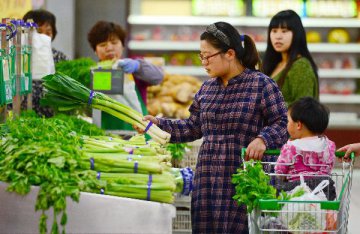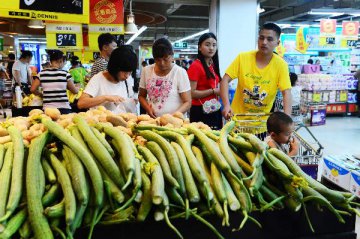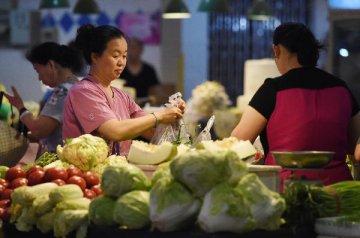
China’s National Bureau of Statistics (NBS) will release the macro economic data for July from this week. Industry insiders estimate that the CPI growth in July was around 1.7 percent year on year, further slowing down compared with June. However, the decline of PPI is expected to narrow. But the growth of investment likely continued to slow down, and is expected to stabilize in the second half year as more policy support will be carried out.
CPI growth expected to slow year on year
The high frequency data of June shows that the inflation of consumer goods continued to slow down rapidly, said Xu Gao, chief economist with Guangda Securities. The falling of pork price led the year on year growth of food prices to maintain at the floor of the fluctuation range of the past six years, hence the month-to-month growth of consumer goods continue to decline. At the same time, as pork price reached the peak during last July and August, the year on year growth of the prices of consumer goods will continue to decline. It is estimated that year on year growth of CPI in July slowed to 1.7 percent.
Li Huaijun, analyst with First Capital is in the view that prices of vegetables of different regions went up due to storms since July. But storms only impacted certain regions for a short time. Therefore the price hike of vegetables in July was limited and didn’t surpass the level of the same period last year. As for the estimated 1.7 percent growth of CPI in July, food and non-food prices went up 3.7 percentage points and 1.3 percentage points, contributing 0.7 percentage points and 1 percentage points to CPI growth respectively.
It is estimated that PPI declined 2.4 percent in July, down 0.2 percentage points from June, according to Li Chao, chief researcher of macro economy with Huatai Securities. Prices of commodities earlier went up following the Brexit, but the prices gradually fell as risk aversion sentiment on the market gradually calm down. In the context of steady global economy and postponed Fed rates hike, the trend of major international commodities becomes uncertain and fluctuates in a certain region in the short term. As the cardinal number was relatively high, it is anticipated that PPI decline will continue to narrow.
Fixed-asset investment likely to decline
“Real estate investment has topped down at present, manufacturing investment continued to weaken, and infrastructure investment maintained nearly 20 percent growth. Overall, fixed-asset investment in July continued to slow. It is estimated that the growth was 8.8 percent, decreasing by 0.2 percentage points from the previous month,” said Lu Zhengwei, chief economist with Industrial Securities.
“More efforts should be made to stabilizing growth, to ensure the commencement of construction of 45 railways be approved by the end of September, build comprehensive three-dimensional transport corridor along the Yangtze River Economic Zone, accelerate the construction of urban underground comprehensive pipeline gallery and promote the construction of various water conservancy projects. On this basis, infrastructure investment will maintain rapid growth. As policy support will be strengthened in the second half year, the growth of investment is expected to be stabilized,” said Lian Ping, chief economist with Bank of Communications.
“Bottoming out of the economy and recovery of the economic efficiency were the latest judgments of the macro economy in the early stage. The key to stabilizing demand is investment, and the key of pick-up of investment is the recovery of private investment. The most important measures for the improvement of private investment are the implementation and advancement of private-public-partnership (PPP) projects. After more than half year of investigation earlier, supporting policies aiming at promote private investment and PPP are in brewing. It is estimated that more pertinent measures will be taken in the future,” said Hu Yuexiao, economic analyst from Shanghai Securities.
Chen Jianheng, analyst with China International Capital Corporation limited, indicated that consumable retail may remain stable at a low level, and it is estimated that year on year growth of consumable retail in July slowed to about 10.5 percent.
Economy as a whole remains steady
Statistics from the NBS shows that accumulated profits of industrial enterprises overall maintained steady growth in June, and the growth rate of profits recovered in that month. “It is estimated that profits of industrial enterprises will to some extent affected during the process of de-capacity. As small illegal and low efficiency enterprises are gradually obsoleted and large enterprises push forward merging and restructuring and structural improvement, industrial enterprises above designated scale in relevant industries will benefit. But the weak economic environment will continue, and de-capacity will to some degree drive the cost price higher, which likely impacts corporate profits. Generally, it is highly possible that profit growth during the year will maintain the trend of stable and low growth.
Xu indicated that it becomes increasingly certain that the economy will stabilize in the second half year. With the synergy effect of stabilizing growth and promoting reform, it will provide stronger impetus for stabilizing growth. Credit and social financing will be supplied at faster speed, and willingness to invest in real economy will recover, thus the economy is likely to remain steady.
Hu says that stable monetary policy will continue, and the growth rate of money supply will not decline continuously. In the near term, expectation of loose monetary environment overseas will continue and become stronger, while China’s pressure of capital outflow will reduce. As Insufficient basic money supply increases pressures on steady monetary supply, the odds of a reserve requirement ratio (RRR) cut in the future increases. It is anticipated that a RRR cut will be seen within in one to three months. But a RRR cut will simply aims at hedging the pressure, and it does not mean a turnaround to ease monetary policy.
Translated by Adam Zhang























Latest comments